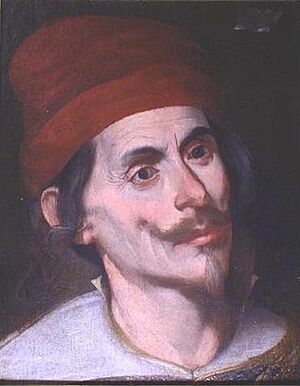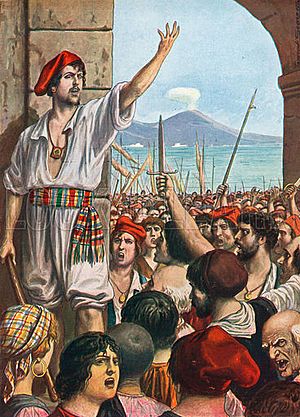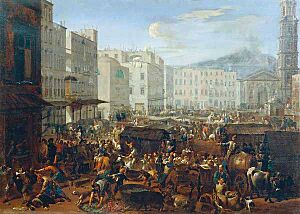Masaniello facts for kids
Masaniello (whose real name was Tommaso Aniello) was an Italian fisherman. He lived from 1620 to 1647. He became a famous leader of a big revolt in 1647. This uprising was against the rule of Habsburg Spain in the Kingdom of Naples.
Contents
Who Was Masaniello?
Masaniello was born on June 29, 1620, in a small lane called Vico Rotto al Mercato in Naples. For a long time, people thought he was from Amalfi. This was because "d'Amalfi" was part of his father's name. It was not a reference to his birthplace.
In 1896, a poet named Salvatore Di Giacomo found Masaniello's baptism record. It showed he was baptized in Naples. The record said: "On June 29, 1620 Tommaso Aniello son of Cicco d'Amalfi and Antonia Gargano was baptized... in Vico Rotto." This happened in the Church of Santa Caterina. In 1641, Masaniello married Bernardina Pisa in the same church.
Historians believe the confusion about his birthplace was kept alive on purpose. The Spanish rulers in Naples did not want to admit that a rebel who challenged their power was from Naples itself. On July 7, 1997, Naples honored Masaniello with a special sign in Vico Rotto al Mercato. This was 350 years after the revolt.
Masaniello's Early Life
Masaniello's family was not rich, but they were not poor either. His father, Francesco (Cicco) d'Amalfi, was a fisherman and shopkeeper. His mother, Antonia Gargano, was a housekeeper. Masaniello had two younger brothers and one sister. His brother Giovanni also became a leader in the rebellion.
Their home was in the Pendino area of Naples. This area was close to where taxes on fish and flour were collected. Naples was a very large city at that time, with about 250,000 people. The Market Square was the busiest place. It had many stalls and was a place for public events.
In the 1640s, Spain was fighting many wars. To pay for these wars, the Spanish rulers put very high taxes on the people of Naples. This made life very hard for ordinary people.
Masaniello worked as a fisherman and sold fish, just like his father. People described him as a young man of 27. He was said to be handsome, with a brown face from the sun. He had black eyes and blond hair.
He often tried to avoid paying taxes by taking fish directly to rich families. But tax collectors often caught him and put him in jail. He was also known for smuggling goods. In 1646, he was already famous for being a skilled smuggler. He sometimes worked for rich nobles, who treated him very poorly.
One time, his wife Bernardina was arrested for bringing flour into the city without paying tax. She was jailed for eight days. Masaniello had to pay a large amount of money to free her. This made him very angry and determined to fight for the people against unfair rulers.
While in prison, Masaniello met Marco Vitale, a lawyer. Marco Vitale connected him with other middle-class people. These people were also tired of the unfair taxes and the special treatment given to nobles. Masaniello also became a student of Don Giulio Genoino. Genoino was an old priest who had a history of defending the common people. He had fought for people's rights before and was a strong leader.
The Naples Revolt
Bad government and very high taxes caused a lot of anger in Naples. A revolt started in Palermo in May 1647. The people of Naples decided to follow their example. The main reason for the Naples uprising was a new tax on fruit and other basic foods. Masaniello became the main leader of this movement.
The revolt began on July 7, 1647. It started with a fight at the city gates between fruit sellers and tax collectors. The tax collectors ran away, and the tax office was burned down. The angry crowd then rushed into Naples. They forced their way into the palace of the Viceroy, Rodrigo Ponce de León. The Viceroy was the Spanish ruler of Naples. He had to hide in a nearby church, then in a castle, and finally in another castle.
Masaniello tried to control the angry crowd. He wanted to stop them from destroying everything. He had some success. Dressed in his fisherman's clothes, he held meetings and made decisions from a wooden platform outside his house. He even ordered the execution of some rioters, including nobles who were causing trouble.
The crowd grew larger and more powerful every day. They got more weapons and became harder to control. They chased away soldiers and chose Masaniello as their "captain-general." The revolt also spread to other parts of the region. Genoino and Masaniello demanded that common people have equal power with nobles in the city council. They also wanted a new set of rules for Naples. Their goal was not to destroy the government. Instead, they wanted to work with the Viceroy to reduce the power of the nobles.
Masaniello led a crowd of almost a thousand people. They broke into armories and opened prisons. This left Masaniello in charge of the city. The Viceroy tried to negotiate with Masaniello. These talks were often stopped by new riots. Finally, the Viceroy agreed to all the demands.
On July 13, 1647, an agreement was signed. Cardinal Ascanio Filomarino, the archbishop of Naples, helped with this. The agreement was between the Duke of Arcos (the Viceroy) and Masaniello. Masaniello was called "leader of the most faithful people of Naples." The agreement pardoned the rebels. It also removed the unfair taxes. The citizens were given certain rights, including the right to stay armed until the King approved the treaty.
Masaniello's Final Days
The clever Duke of Arcos invited Masaniello to the palace. He confirmed Masaniello's title of "captain-general of the Neapolitan people." He gave him a gold chain and offered him money. Masaniello refused the money. He said he wanted to go back to being a fisherman.
But Masaniello stayed at the palace. Because of all the stress and excitement, he started to act strangely. Some people believed he might have been poisoned. He seemed to lose his mind and behaved like a madman.
The Viceroy gave in to some demands. But the nobles of Naples were still against Masaniello. There was an attempt to kill him. However, on July 13, Masaniello was confirmed as Captain-General in a big ceremony. He wore fancy clothes and sat in a golden chair.
Masaniello's behavior became more and more wild. On July 16, he escaped from house arrest. He went to a church where the Archbishop was holding a mass. Masaniello started to shout and insult his fellow citizens. He was arrested again and taken to a nearby monastery. There, a group of grain merchants killed him. They cut off his head and took it to the Viceroy. His body was buried outside the city.
But the very next day, the people changed their minds. They were angry because the rules for weighing bread had been changed. They regretted their actions against Masaniello. His body was dug up and given a grand funeral. Even the Viceroy sent someone to represent him at the funeral.
The Viceroy tried to let Genoino govern the city. But Genoino could not control the angry crowds. Extreme groups took over. A second revolution happened in August. This led to Genoino being sent away. A Neapolitan Republic was declared, supported by France. However, the Spanish eventually took back control of Naples in April 1648.
Masaniello in Art and Culture
Masaniello has been shown many times in paintings from Naples in the centuries after his death.
- The philosopher Baruch Spinoza reportedly drew a picture of Masaniello. The drawing looked a lot like Spinoza himself, showing him as a fisherman.
- Masaniello's revolt was mentioned by the philosopher John Locke. He used Masaniello as an example in his writings about government.
- Many poets from Naples wrote about Masaniello's revolt. Some were critical of it, while others expressed regret.
- Thomas Paine, who wrote Common Sense, warned against leaders like Masaniello. He said it was better to create a government carefully than to let someone like Masaniello take over during troubled times.
- Masaniello's story inspired many artists and composers. Several operas were made about him. These include Masaniello furioso (1706) and Daniel Auber's La Muette de Portici (1828). Auber's opera was so powerful that it made the audience leave the theater and start the real-life Belgian Revolution of 1830!
- In 2019, a movie about the famous Argentine footballer Diego Maradona was released. In the film, a broadcaster compares Maradona to Masaniello. Maradona had asked the people of Naples to support his Argentine team in the 1990 World Cup semi-final. Argentina won that match.
See also
 In Spanish: Masaniello para niños
In Spanish: Masaniello para niños
- History of Naples
- Neapolitan Republic (1647)
- Giulio Genoino
- Gennaro Annese




